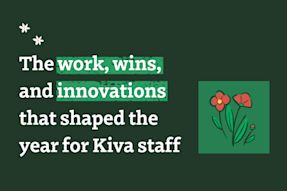“There’s potential for affecting a lot of people’s lives through agriculture,” said Natalie Miller, CEO of GreenFingers Mobile. “There are 250 million small farmers in Africa, but the number of people who depend on it for their livelihoods is 6 times that - so you’re looking at a big chunk of the population of Africa!”
She’s right - 70% of the population of Africa earns a primary living from agriculture. About 90% of that segment represents subsistence farmers, producing crops mainly to feed their families and bringing in little to no additional income.
But often this is not for lack of surplus - the small-scale and remote nature of these farms often excludes them from the larger agriculture market. For food companies, the amount of product that can be sourced from these farms is too small to cover the high costs of managing hundreds or thousands of individual smallholder farms. On their own, smallholder farmers cannot access demand for crops outside of their own communities. Even intermediary agribusinesses that manage large groups of smallholder farmers have a hard time contracting with food companies because of high administrative costs and lack of formal reporting practices.
 Smallholder farmers in Sub-Saharan Africa
Smallholder farmers in Sub-Saharan AfricaDespite the high costs of local sourcing, a South-African based international fast food chain called Nando’s began exploring the possibility of procuring from small farmers rather than just commercial farms. They soon discovered that every intermediary agribusiness they wanted to contract still used pen-and-paper administrative systems. They had no ability to report real-time data, but Nando’s needed a way to efficiently and transparently manage small farmer networks.
Enter GreenFingers Mobile. Established in 2016, the company piloted a mobile technology platform to streamline the management of smallholder farmers. The technology cuts the high administrative costs of sourcing from smallholder farmers by digitizing reporting by intermediaries so that larger food companies can buy their crops. It also provides transparency for stakeholders through real-time data.
“It enables big buyers to actually contract these agribusinesses,” Natalie said. “Thus bringing formerly subsistence farmers into contract farming, many times for the first time earning an income.” This unlocks an enormous supply of local agricultural product for food corporations, as well as gives small farmers access to market demand.
As agribusinesses input and store commercial transaction data on the platform, it generates a virtual CV for each farmer, enabling them to start building a credit record and access finance.
 GreenFingers Mobile platorm replaces pen-and-paper management systems
GreenFingers Mobile platorm replaces pen-and-paper management systemsWhen Natalie joined in April 2018, the still-young GreenFingers had grown to manage over 8,000 farmers across 3 countries. She realized it was operating a very expensive model that was difficult to scale. It was still priced out of reach for some small agribusinesses. GreenFingers had just raised seed funding from Hivos Food and Lifestyle Fund in the Netherlands to cover costs over several months. However, Natalie quickly realized that the funds needed to be diverted to redevelop the GreenFingers system. This created a cash flow problem.
“It’s really tough for social enterprises and startups to raise cash, especially in Africa and the developing world,” Natalie said. Often, social enterprises like GreenFingers are too large to benefit from microfunding, but have a hard time getting financing from the formal banking sector.
In order to address this common problem in the social sector, in 2016 Kiva expanded to offer loans directly to social enterprises: for-profit companies that have a measurable positive social impact and a sustainable business model. While most individual Kiva loans range from a few hundred to a few thousand dollars, Kiva’s social enterprise loans range from $10,000 to $50,000.
In 2018, GreenFingers was approved for a $15,000 loan from Kiva. “At the time I knew it would be helpful, but I didn’t know just how essential it would be,” Natalie said. The loan enabled GreenFingers to stay in business while rebuilding a completely new scalable product that incorporated client feedback and decreased the cost to clients by 66%.
“We didn’t realize how much we needed the Kiva loan just to keep the lights on.”
 GreenFingers' updated product cuts costs to clients by 66%
GreenFingers' updated product cuts costs to clients by 66% Looking forward, after repaying the loan, GreenFingers will continue to expand its reach in agriculture as well as in microfinance. The company is considering a potential field partnership with Kiva in the future.
Microfinance institutions often have a hard time lending to farmers because they don’t account for the seasonal revenue patterns in agriculture. GreenFingers can use its existing platform to facilitate farmer-friendly microloans and offer financing services to its customers with Kiva. “If we can bridge that knowledge gap and facilitate financial inclusion as well as income generation, that’s fantastic,” Natalie said.
When it comes to making an impact at scale, GreenFingers sets the tone for social innovation in African agriculture and reflects a larger trend toward investment in the industry. Technology like GreenFingers is changing the agricultural sector worldwide, and the Sub-Saharan African agricultural market is projected to grow fivefold by 2030, from $200 billion in 2015 to $1 trillion. The inclusion of more than 250 million small farmers into the global agriculture market will not only make Africa one of the globe’s major food producers, but will also create impact on the ground at a large scale.
Interested in supporting agriculture in Sub-Saharan Africa? Click here.
PREVIOUS ARTICLE
Dreams run in the family in Colombia →NEXT ARTICLE
Lender spotlight: Sherry incentivizes lending through art →














